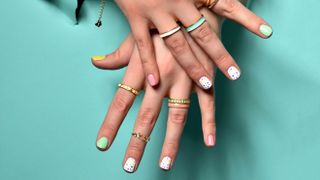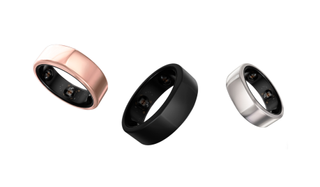
Fitbit may be branching out from watch-style fitness trackers and developing a new smart ring, according to a newly registered patent. The document gives details of 'a ring for optically measuring biometric data' – specifically blood oxygen saturation (SpO2).
That's particularly interesting, because SpO2 measurements from a ring have the potential to be more accurate than those taken by a watch.
- We've tested and ranked the best running watches
- We'll also help you choose the best running shoes
- On a budget? Check out the best cheap running watches
The type of pulse oximeter used in a clinical environment, which clips onto your finger, toe or earlobe, works by passing a light through your skin and blood vessels to a photodetector on the other side. Oxygenated and deoxygenated red blood cells absorb light differently, so the properties of the light that passes through your finger, toe or ear can reveal how much oxygen is in your blood.
That's not possible with a device worn on your wrist, which must use reflected light instead. Richly oxygenated blood reflects more red light than infrared light, and poorly oxygenated blood reflects more infrared light than red light.
Data from the ring could then be sent to the Fitbit app on your phone, or to a Fitbit watch. The patent suggests that this could be done via Bluetooth or NFC.

A Fitbit smart ring would be a direct competitor to the Oura Ring, which measures heart rate, heart rate variability, respiration rate and body temperature at night. However, while the Oura Ring comes into its own at night, it looks like the Fitbit ring would be most useful during the day, with "a motion sensor [to] determine opportune moments for data collection, such as when the wearer is still".
Keeping still is important because movement causes interference, which has a big effect on accuracy. That's why the Polar Verity Sense heart rate monitor, which is worn on the upper arm, typically gives more consistent readings than a watch, despite using the same type of optical sensor.
Get daily insight, inspiration and deals in your inbox
Get the hottest deals available in your inbox plus news, reviews, opinion, analysis and more from the TechRadar team.
Smart bling
Many patents come to nothing, and there's no guarantee that the Fitbit ring will become reality, but the company has recently begun moving in a jewelry-focused direction. The Fitbit Luxe, which recently took the top spot in our roundup of the best fitness trackers, is available with a gold-toned stainless steel link bracelet created by jewelry designer Gorjana – a company that also produces a wide range of modern looking rings.
The patent registration suggests several possible designs for a Fitbit smart ring, including a regular ring, a larger device worn on the thumb, and even a combination of rings, each of which serves a different purpose (perhaps similar to Gorjana's stackable ring sets).
Fitbit filed its first patent application for a smart ring in 2019, and has been developing the idea ever since, so we'll be keeping a close eye out for more hints in the near future.
- We've rounded up the best sleep trackers you can buy
Cat is the editor of TechRadar's sister site Advnture. She’s a UK Athletics qualified run leader, and in her spare time enjoys nothing more than lacing up her shoes and hitting the roads and trails (the muddier, the better)

